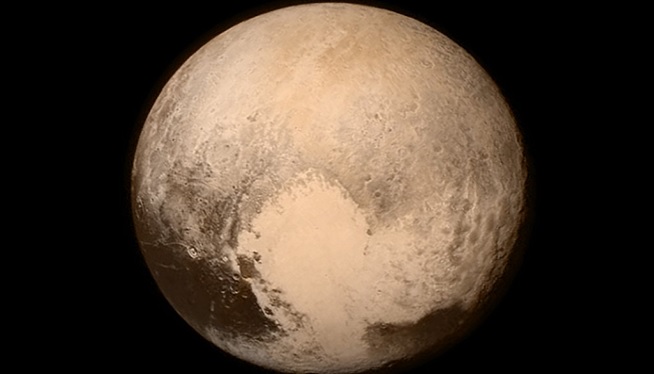LAUREL, MD — (CNN) NASA has re-established contact with its New Horizons spacecraft after a planned communications blackout as the probe completes humankind’s first flyby of Pluto.
Mission managers who were packed into the New Horizons “mission control” room anxiously waiting to hear from the spacecraft broke into applause.
The probe had spent more than 12 hours out of contact while it collected data from Pluto and its five moons.
The communications outage was planned, but it still had scientists on edge. The flyby was the most dangerous part of the mission; there was a chance that stray dust in the Pluto system could collide with the spacecraft.
NASA administrator Charles Bolden joined mission manager Alice Bowman to congratulate the team in the mission operations center. Bowman said the probe is healthy and “outbound” from Pluto.
NASA opened its flyby “phone home” briefing with a congratulatory message from Stephen Hawking.
The unmanned piano-size spacecraft went over Pluto at 7:49 a.m. ET, traveling at nearly 31,000 mph about 7,750 miles above Pluto’s surface, NASA said.
“I have to pinch myself,” Bowman said Tuesday morning. “Look what we accomplished.”
But the fun is just beginning.
Alan Stern, the mission’s principal investigator, said earlier that New Horizons should transmit a message back to the Earth for about 20 minutes.
“We’ll find out how it’s doing — whether it survived the passage through the Pluto system. Hopefully it did,” Bowman said. “We’re counting on that. But there’s a little bit of drama because this is true exploration. New Horizons is flying into the unknown.”
The planet already is dazzling mission managers. They said Pluto could have been covered in clouds and they wouldn’t have seen much.
But instead, Stern said they’re seeing a world with “various kinds of brightness, very dark regions near the equator, very bright regions just to the north of that and a broad intermediate zone over the pole.”
And there’s snow. Yes, snow.
“Pluto has strong atmospheric cycles. It snows on the surface,” Stern said.
“Pluto has turned out to be an extraordinarily complex, interesting world,” said NASA Associate Administrator John Grunsfeld.
The New Horizons team on Tuesday released the best photos of Pluto that they’ve gathered during its mission. But Wednesday, they expect to release photos from the close encounter, and they’ll continue getting data back from the probe for 16 months.
Scientists on Monday said New Horizons already has settled one debate about Pluto — its size. Information gathered by the probe indicates Pluto is 1,473 miles (2,370 kilometers) in diameter. That’s somewhat bigger than earlier estimates, and it means Pluto is larger than all other known solar system objects beyond the orbit of Neptune.
The Pluto flyby mission completes what NASA calls the reconnaissance of the classical solar system, and it makes the United States the first nation to send a space probe to every planet from Mercury to Pluto. The probe traveled more than 3 billion miles to reach Pluto.
Stern noted that Tuesday’s Pluto flyby came exactly 50 years after the Mariner 4 probe accomplished the first flyby of Mars.
“I think it’s fitting that on that 50th anniversary we complete the initial reconnaissance of the planets with the exploration of Pluto,” he said Tuesday.
New Horizons looks like a gold foil-covered grand piano. It is 27 inches (0.7 meters) tall, 83 inches (2.1 meters) long and 108 inches (2.7 meters) wide. It weighed 1,054 pounds (478 kilograms) at launch. It has seven instruments on board to map the surfaces of Pluto and its largest moon, Charon. It also is studying their atmospheres.
The spacecraft was launched on January 19, 2006, before the big debate started over Pluto’s status as a planet. In August of that year, the International Astronomical Union reclassified Pluto as a dwarf planet.
But Stern disagrees with the IAU’s decision.
“We’re just learning that a lot of planets are small planets, and we didn’t know that before,” Stern said earlier. “Fact is, in planetary science, objects such as Pluto and the other dwarf planets in the Kuiper Belt are considered planets and called planets in everyday discourse in scientific meetings.”
After surveying Pluto, New Horizons will keep flying, heading deeper into the Kuiper Belt, a region that scientists think is filled with thousands of small, icy objects. NASA and mission managers will decide later this year whether to extend the mission to study another small world in the Kuiper Belt.
The-CNN-Wire ™ & © 2015 Cable News Network, Inc., a Time Warner Company. All rights reserved. (PHOTO: NASA)





















